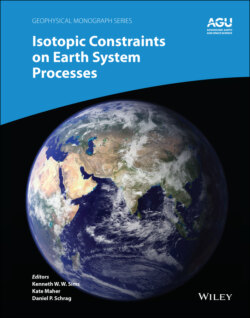Читать книгу Isotopic Constraints on Earth System Processes - Группа авторов - Страница 62
2.6. CONCLUSIONS AND POSSIBLE FUTURE APPLICATIONS
ОглавлениеWe performed a set of diffusion couple experiments involving unusual phonolite and rhyolite compositions. The data and analysis of those experiments presented here provides additional β factors needed for modeling reaction and transport processes in high temperature geologic systems. Despite the complicated nature of the diffusion profiles, which is an inevitability when dealing with natural silicate liquid compositions, we showed how one can extract a meaningful β factor from the diffusion profiles using a modified effective binary diffusion model that was first developed by Zhang (1993). Our results confirm that β factors vary depending on the element as well as liquid composition, and also that large diffusive isotope effects can arise even in the absence of a large initial concentration gradient. The retrieved β factor for Ca is typical of Ca in natural silicate liquids whereas the β factor for K is the highest value yet reported, suggesting that large diffusive K isotope effects may yet be found in high‐T environments.
One of the goals of this type of experimental study is to use the growing compilation of β factors to better understand how the mobility of key chemical constituents is controlled, and how that mobility relates to isotopic fractionation of Ca, Mg, Fe, Si, and K in high temperature systems. Recent work shows how isotopic effects in these elements can be used as tracers of micro‐ and nano‐scale processes at mineral surfaces and transport within geologic media at larger scales. For example, Antonelli et al. (2019a) documented small Ca isotope fractionations between volcanic phenocrysts (plagioclase, clinopyroxene, hornblende, and olivine) of various sizes (mm to cm) in lavas ranging in composition from alkali basalt to rhyodacite. They interpreted the effects as being due to diffusive isotope fractionation during crystal growth superimposed on small equilibrium fractionation effects. With knowledge of β factors, they used the model of Watson and Müller (2009) to show how Ca isotope fractionation could be used as a measure of crystal growth rates. They inferred plagioclase growth rates of order 0.03 to 0.3 cm/yr, which is in broad agreement with other estimates of typical volcanic phenocryst growth rates. This approach can be extended to other K‐bearing minerals (e.g., K‐spar, muscovite) using K isotopes in lieu of Ca isotopes.
Another example is the study by Chopra et al. (2012), who used their knowledge of Mg isotope fractionation effects to evaluate the isotopic gradients at the boundaries of a pillowed mafic dike intruded into a granitic intrusion at Vinalhaven, Maine. They used the isotope effects to confirm that diffusion was responsible for the chemical gradients and estimated a diffusion timescale for cooling of the dike‐granite system. We envision extending this to other elements (Ca and K) and other sites. There are many field localities where a mafic (gabbroic) magma with 6–8% CaO and < 1% K2O has intruded a more silicic (granitic) body with 1–2% CaO and 2–5% K2O. The Ca concentration gradient is downward toward the granitic phase and the K concentration gradient is downward toward the gabbroic phase. We anticipate that the use of two or more isotopic systems, such as Ca and K, with different temperature‐dependent diffusivities could provide unique information on mixing and cooling processes in magmatic systems.
